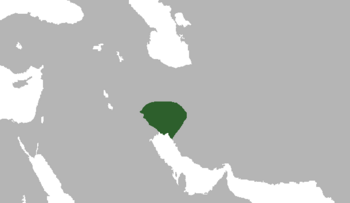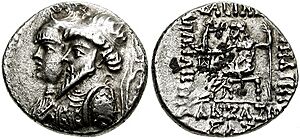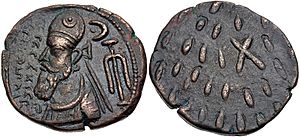Elymais facts for kids
Quick facts for kids
Elymais
|
|||||||||
|---|---|---|---|---|---|---|---|---|---|
| 147 BC–221/222 AD | |||||||||
|
Elymais anchor emblem, Based on Elymais coinage.
|
|||||||||

Approximate extent of Elymais in 51 BC.
|
|||||||||
| Status | Autonomous state, frequently a vassal of the Parthian Empire | ||||||||
| Capital | Susa | ||||||||
| Government | Monarchy | ||||||||
| King of Elymais | |||||||||
|
• ca. 147 BC
|
Kamnaskires I Soter | ||||||||
|
• 221/222 AD
|
Orodes V | ||||||||
| Historical era | Classical antiquity | ||||||||
|
• Established
|
147 BC | ||||||||
|
• Disestablished
|
221/222 AD | ||||||||
|
|||||||||
Elymais or Elamais was an ancient kingdom that existed from about 147 BC to 222 AD. It was located at the top of the Persian Gulf, in what is now Khuzestan, Iran. The name "Elymais" comes from the older name "Elam".
Elymais was an independent state, but it was often under the control of the powerful Parthian Empire. The people of Elymais were known for being excellent archers. Many of them were likely descendants of the ancient Elamites, who had lived in that area long before. The kingdom had several regions, including Massabatice, Corbiane, and Gabiane.
We don't know much about the language spoken in Elymais. However, some writings in Aramaic have been found there. The kingdom of Elymais lasted for a long time until it was conquered by the Sasanian Empire in the early 3rd century AD.
Wealth and Ancient Stories
The region of Elymais was known for its "wealth in silver and gold." An ancient book called 1 Maccabees mentions Elymais as a rich "city" that Antiochus IV Epiphanes wanted to attack. The story says that its temple had many valuable items, including golden coverings and weapons left by Alexander the Great.
Antiochus tried to take the city and its treasures, but he couldn't because the people found out about his plan. It's important to know that Elymais was a country, not just a city, as the book describes. Also, there are no other stories about Alexander leaving treasures in Elymais.
Elymais Coins and Language
The coins made in Elymais usually showed a king. We don't know if this was a Parthian king or a local ruler. These coins were based on Greek money standards. The king's image on the coins often looked like those on Parthian coins, usually with an anchor and a star inside a crescent moon.
On the back of the coins, there was sometimes a picture of Artemis, an eagle, or just many small dots. This suggests that the people who made the coins might not have understood Greek writing, or they copied from coins where the writing was already hard to read.
A special kind of Aramaic writing was used in Elymais. This writing style was more traditional than the Aramaic spoken in other areas nearby. The government of Elymais created its own version of the Aramaic alphabet. It had flowing, connected letters, possibly influenced by the writing style of the Parthian government. However, we don't have proof that Aramaic was spoken by everyone in Elymais. It was mostly used on coins and in official writings found at places like Tang-e Sarvak.
Images for kids
See also
 In Spanish: Elimaida para niños
In Spanish: Elimaida para niños






